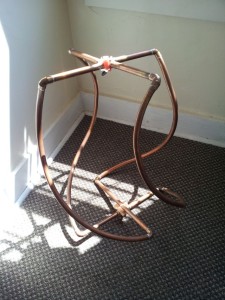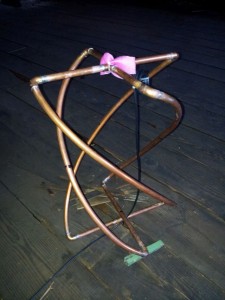After successful first attempt with a piece of wire – how to improve reception from the NOAA satellites?
The APT images are sent down at about 137 MHz, with circular polarization. A little search of the web, and it’s pretty clear that there are multiple types of antennas that will work well. Of course, a fully azimuth-elevation controlled YAGI array would be best, but, no need to get too fancy.
There seem to be multiple, equally suitable approaches – I selected a quad-helix type design, because it’s something that I haven’t made before, at least not, for the 137 MHz band, and would present a little challenge in copper tube bending and soldering.
First attempt – well, it looks a bit out of shape, and it is. Still, not too bad, and relatively broadband.
I thought, I could do better with a somewhat modified design, here we go:
Construction hints:
(1) Use about 1/2″ (15 mm) outer diameter pipe. This is very strong, and can be used indoors and outdoors, will last a long time. Sure, you can also use 3/8″ or 10 mm, whatever is handy.
(2) For the straight pieces, best use hard copper pipe, this makes it easier to adjust the loops by some pulling and bending.
(3) Don’t worry about complicated baluns. A few turns (5-7) of RG58 coax is all that is needed, at least from my experience.
(4) No need to use any special cable, just plain RG58 will do. If you run long length, use a little pre-amplifer. Don’t set the gain too high – just about enough to compensate the cable losses.
(5) Soldering doesn’t need to be perfect, because this construction will not need to hold any water. It’s just an antenna.


